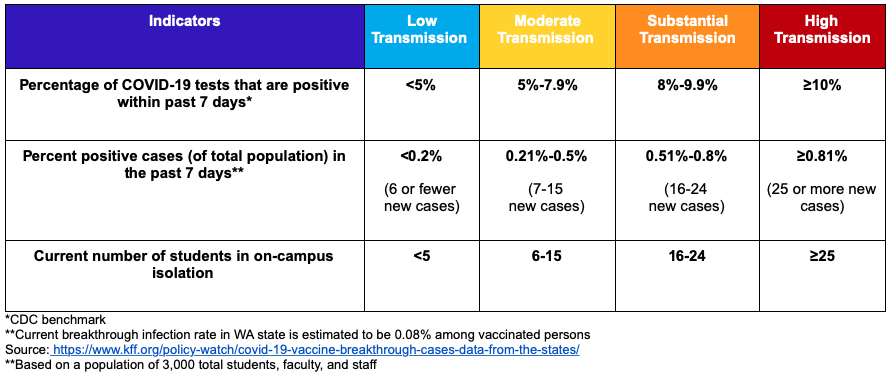Dear Members of the Campus Community,
Working with our public health consultant, Tegria, the university has determined the following thresholds to help guide decision-making about campus operations and activities as we progress further into the fall semester. These indicators and their definitions will be available on the COVID-19 dashboard by the end of the month, and we will track campus transmission accordingly.
These indicators are part of a range of factors influencing our COVID-19 response, including proclamations and guidance issued by Gov. Inslee; Tacoma-Pierce County Health Department guidance and recommendations; contact tracing capacity and effectiveness; access to personal protective equipment (PPE); and other considerations.

DEFINITIONS
Low Transmission. Few individuals have tested positive and each individual has only a few close contacts, keeping cases restricted to a small population. Isolation and quarantine measures are likely sufficient for containment. All campus activities continue to follow the basic campus guidelines outlined for the Fall 2021 semester. CHWS, Residential Life, Dining, Campus Security, and Facilities staff can easily manage the needs of students in quarantine/isolation housing. Randomized asymptomatic surveillance testing may be conducted. Targeted individual diagnostic testing will be reserved for close contacts and people with COVID-19 symptoms.
Moderate Transmission. Cases are primarily within a specific subsection of the community (such as a residential hall, academic/administrative building, team, event participants, or classroom). There is a moderately high level of confidence in the accuracy of contact tracing due to the speed of test results and the number of cases. Non-academic indoor events may be limited to less than 75% of normal occupancy capacity. Select programs or areas may have their operations modified (e.g. cease in-person activities) or discontinued. CHWS, Residential Life, Dining, Campus Security, and Facilities staff resources may be strained but still able to manage the needs of students in quarantine/isolation housing. Targeted individual diagnostic testing may be conducted in specific subsections of the community in addition to asymptomatic surveillance testing.
Substantial Transmission. The University of Puget Sound campus or surrounding community has more widespread cases and confidence is decreasing in the ability for test results to be quickly returned and/or for close contacts to be identified. Minimizing contact between community members and those on campus becomes a high priority. In some circumstances, a remediation plan might be necessary to help reduce the rate at which Covid-19 spreads on campus. CHWS, Residential Life, Dining, Campus Security, and Facilities staff resources may be significantly impacted by the needs of students in quarantine/isolation housing and some restructuring of staffing duties may be required. Hybrid academic options and de-densifying academic and other spaces may be implemented. Testing the entire community once over the course of the week may be conducted at this point, in addition to increased asymptomatic surveillance testing.
High Transmission. The rate of campus transmission is high. Essential functions (e.g. care oversight, security, dining) may be compromised due to the number of students and/or employees in isolation. If the transmission rate specifically on campus is high, students who live on campus may be instructed to “shelter-in-place.” Campus operations may be significantly limited to reduce the risk of ongoing transmission. A temporary pivot to remote operations across campus, including academics, may be implemented until case counts decline. The university may switch to weekly asymptomatic surveillance testing campus-wide for a period of time in order to reduce the risk of infection across the Puget Sound community. Campus-wide contact tracing of the entire population may be conducted with the assistance of state and local public health agencies.
Additional Guidelines. Certain campus operations and activities may be modified or temporarily suspended due to public health, professional standards, or other external organizational guidance. For example, in addition to university guidelines, the intercollegiate Athletics program also abides by Northwest Conference and NCAA guidelines.
We hope this guidance provides a clearer picture of how the university is prepared to respond as needed throughout the semester. This includes important information shared by Counseling Health and Wellness Services earlier today about testing protocols following fall break.
Thank you for everything you continue to do, day in and day out, to protect the health and wellbeing of the campus community.
Sincerely,
Isiaah
Isiaah Crawford, Ph.D. | President